Championing Women Orthopaedic Surgeons: Preparing for an Inclusive Future (Updated) .
Guest contributors Dr. Laurie Hiemstra and Dr. Nancy Hiasat offer candid reflections on the persistent underrepresentation of women in orthopaedic surgery. Despite growing awareness, barriers such as gender bias, lack of mentorship, and work-life imbalances remain. Both leaders emphasize that improving equity requires systemic change, allyship, and intentional leadership. With diverse teams shown to improve outcomes, the path forward lies in fostering mentorship, visibility, and structural support for women in orthopaedics.
Unlock the Full original article
You have access to 4 more FREE articles this month.
Click below to unlock and view this original article
Unlock Now
Critical appraisals of the latest, high-impact randomized controlled trials and systematic reviews in orthopaedics
Access to OrthoEvidence podcast content, including collaborations with the Journal of Bone and Joint Surgery, interviews with internationally recognized surgeons, and roundtable discussions on orthopaedic news and topics
Subscription to The Pulse, a twice-weekly evidence-based newsletter designed to help you make better clinical decisions
Exclusive access to original content articles, including in-house systematic reviews, and articles on health research methods and hot orthopaedic topics
































































